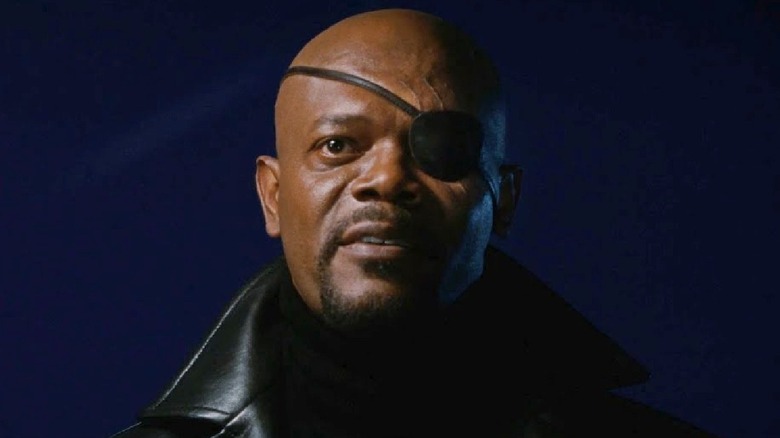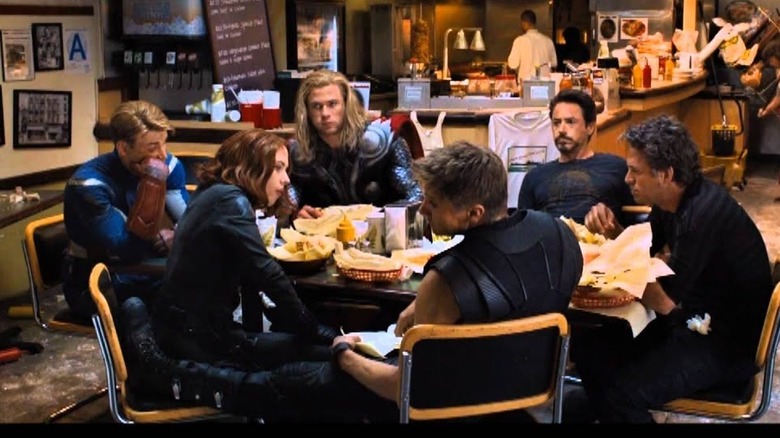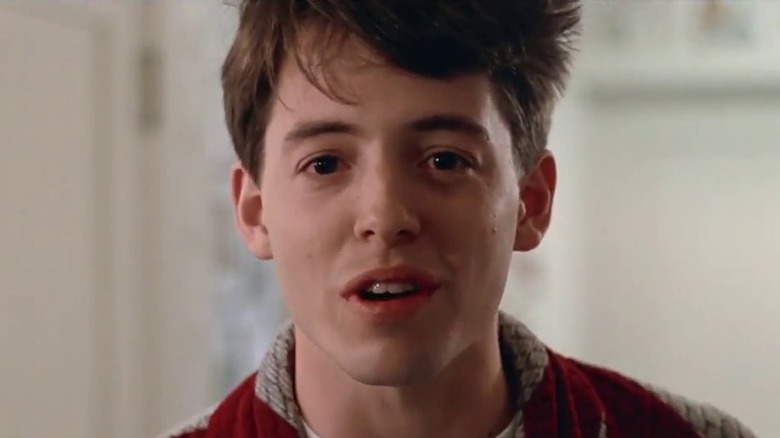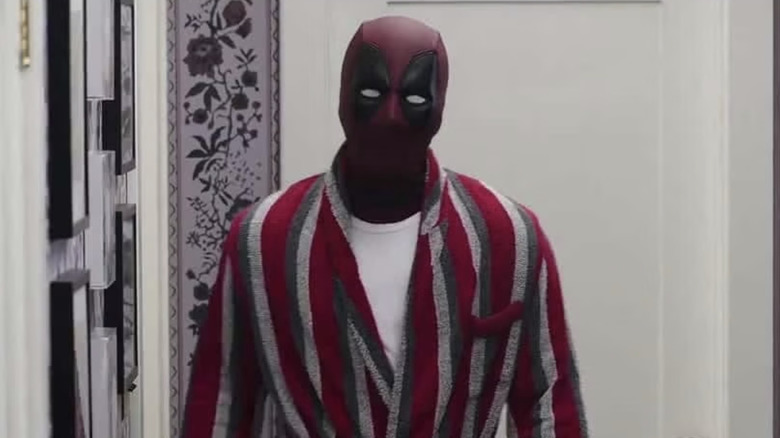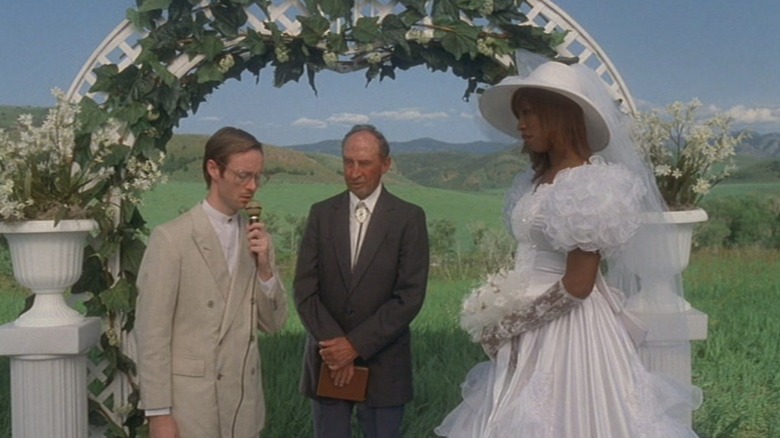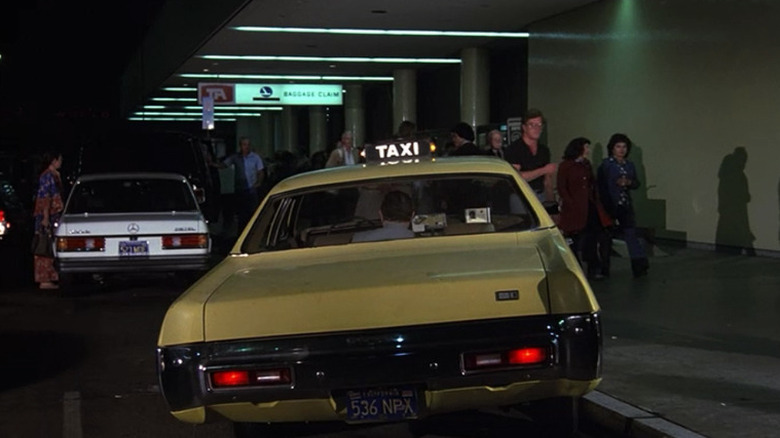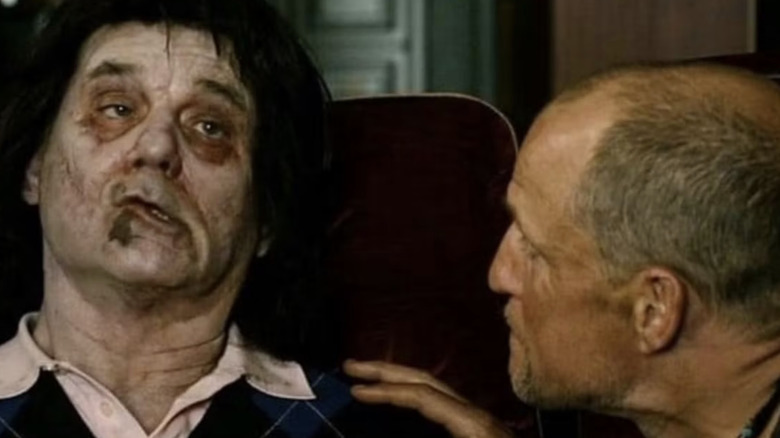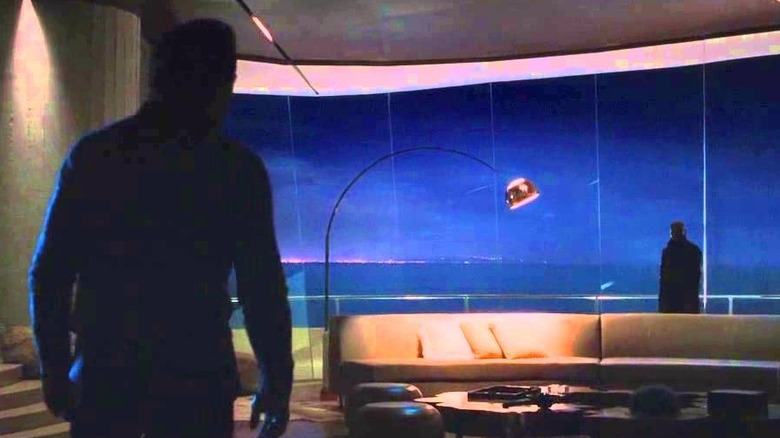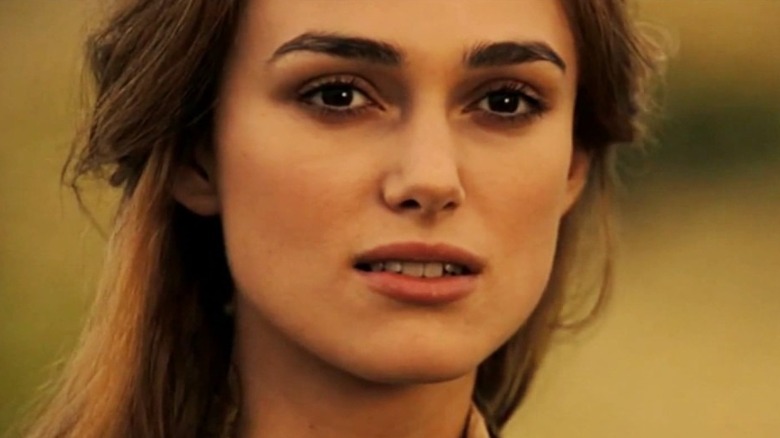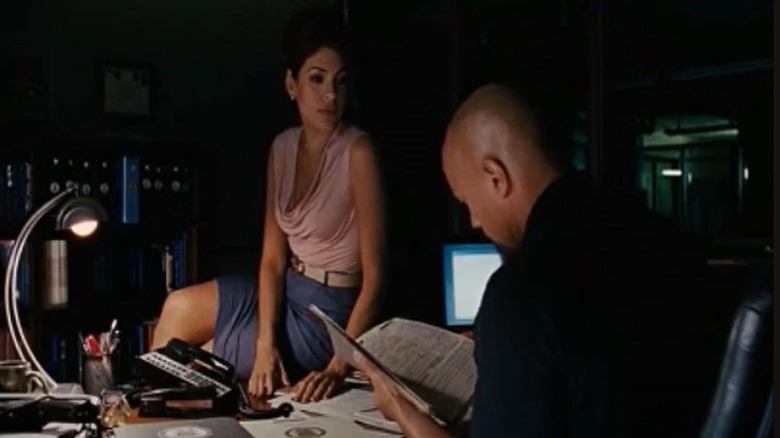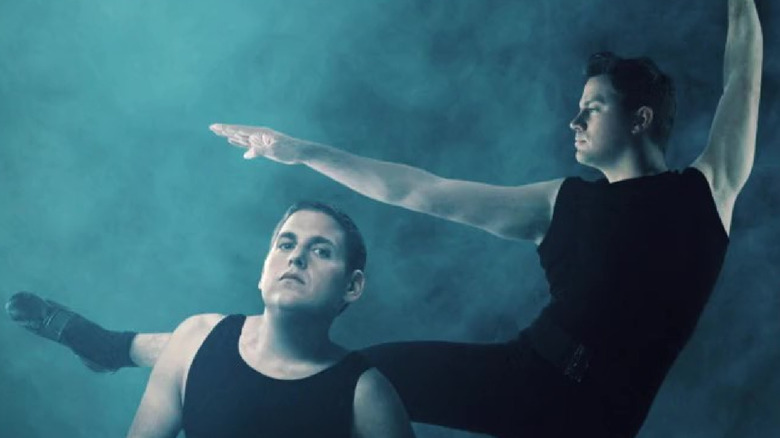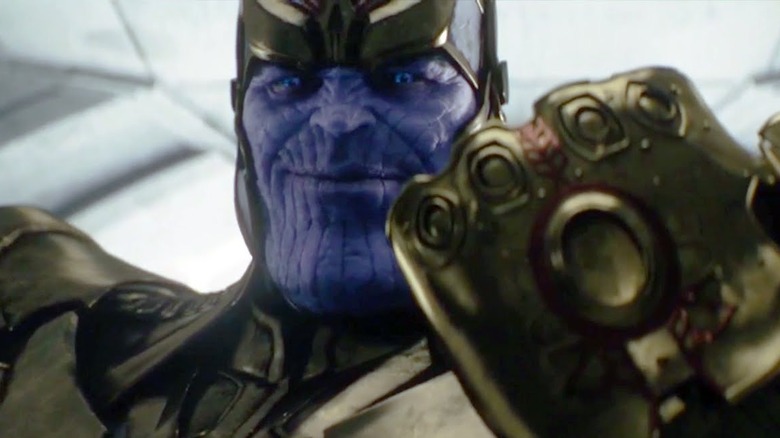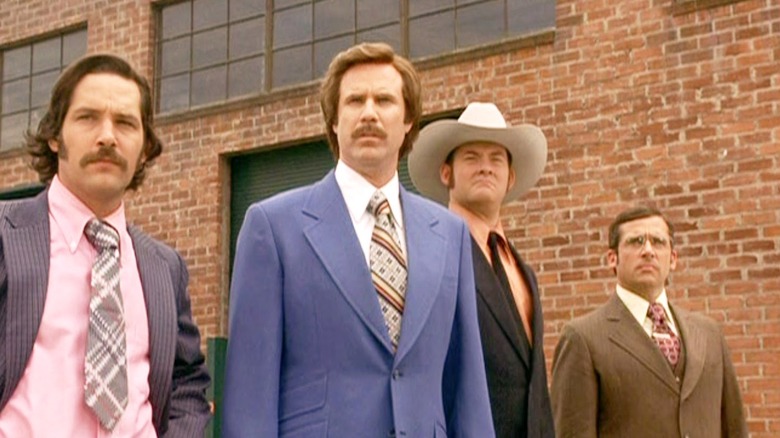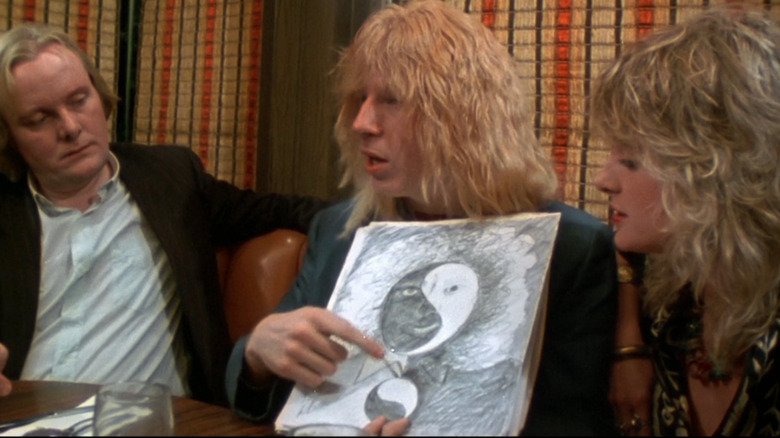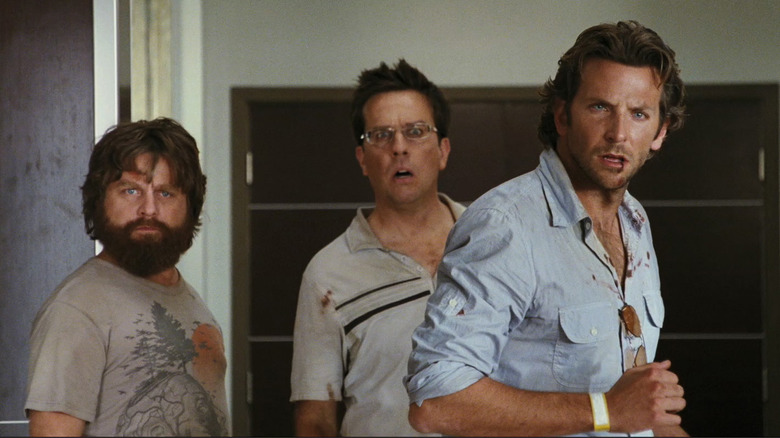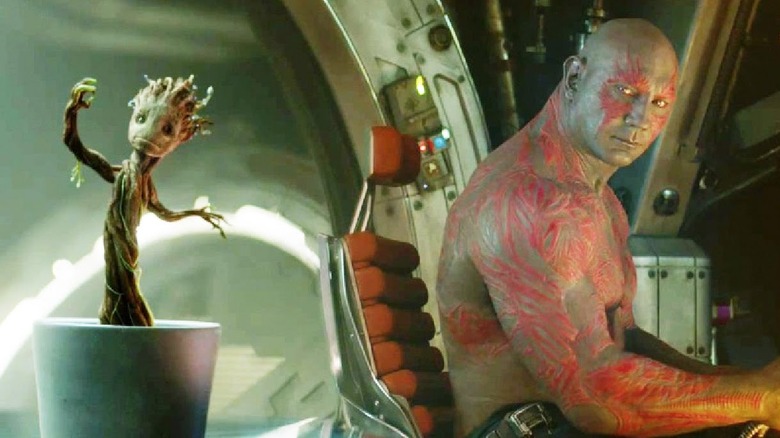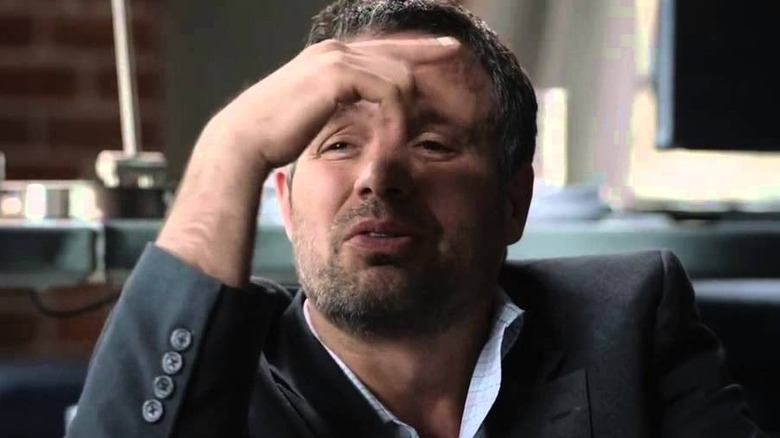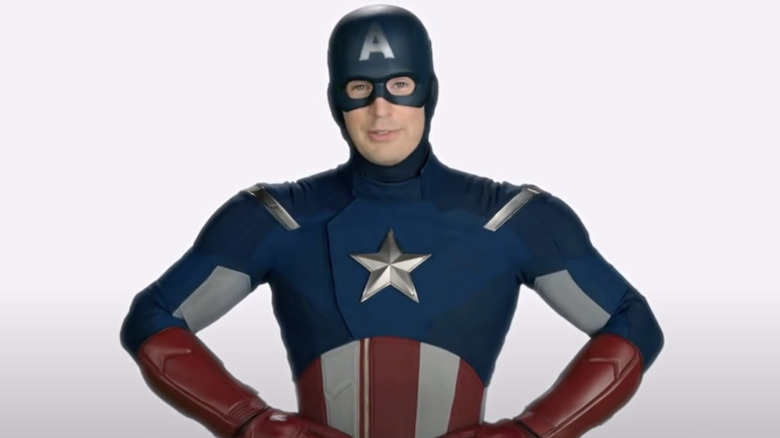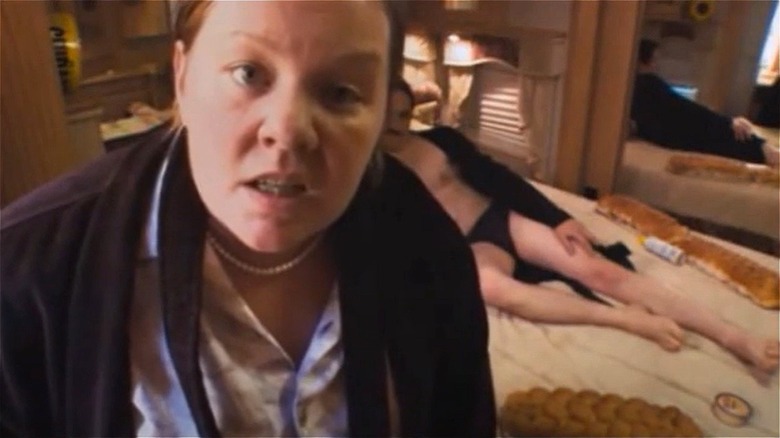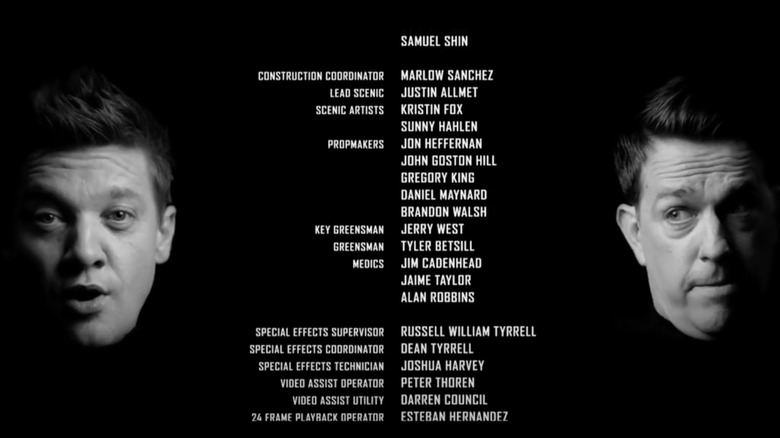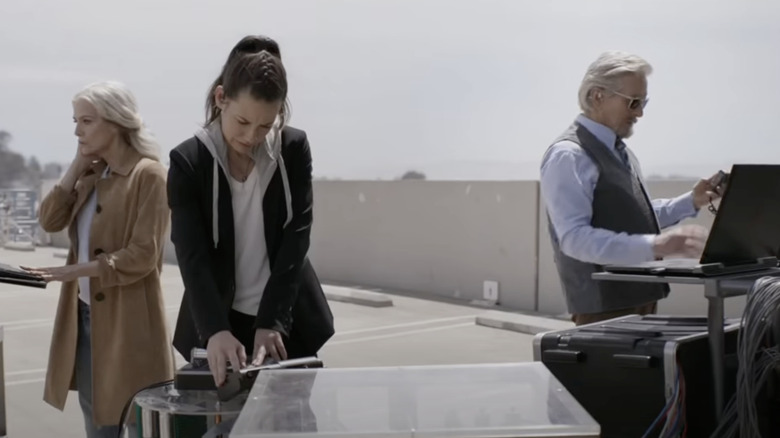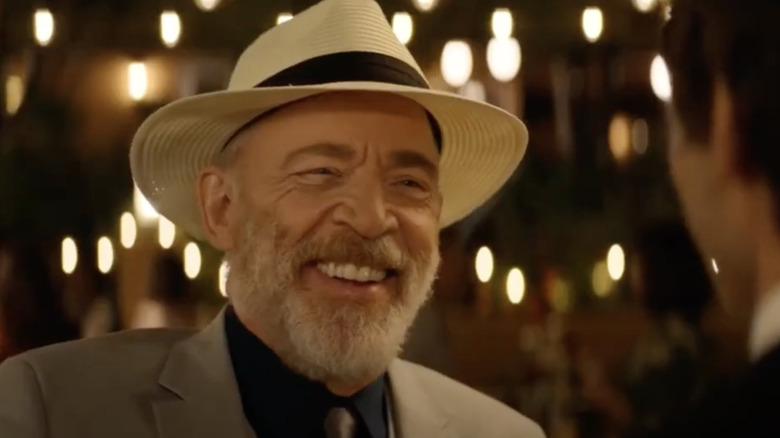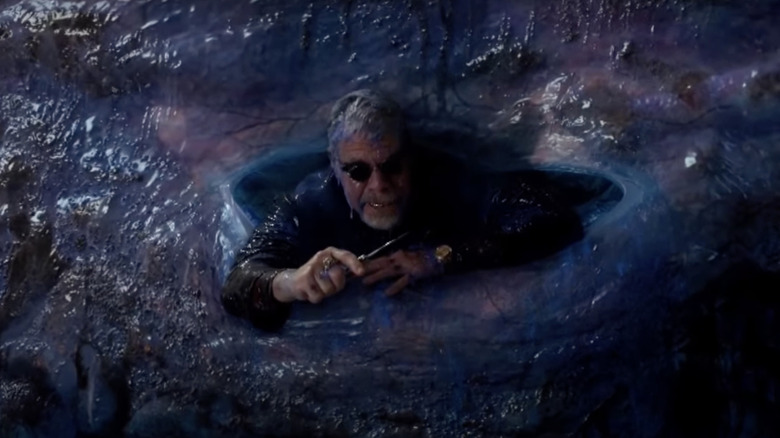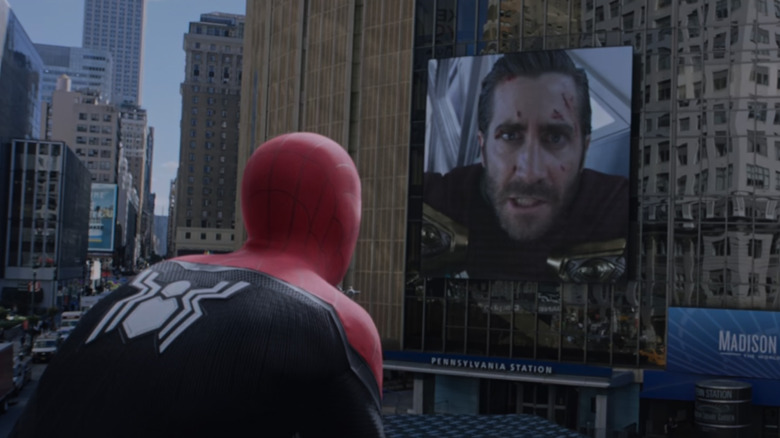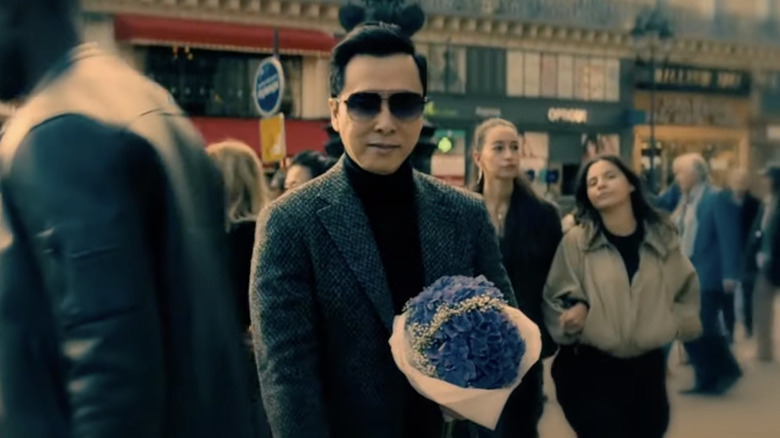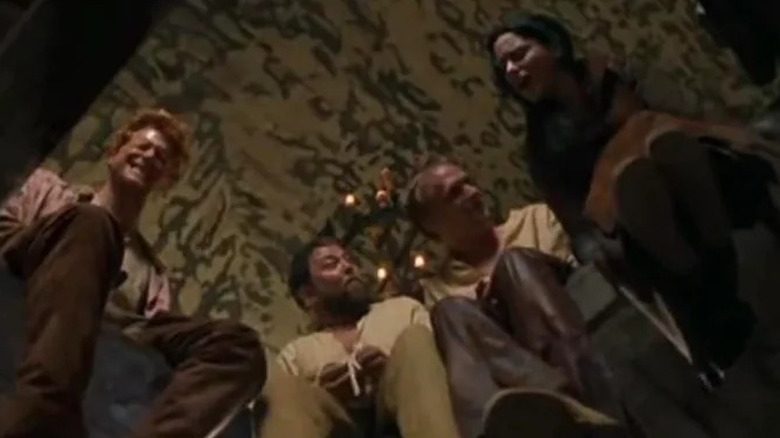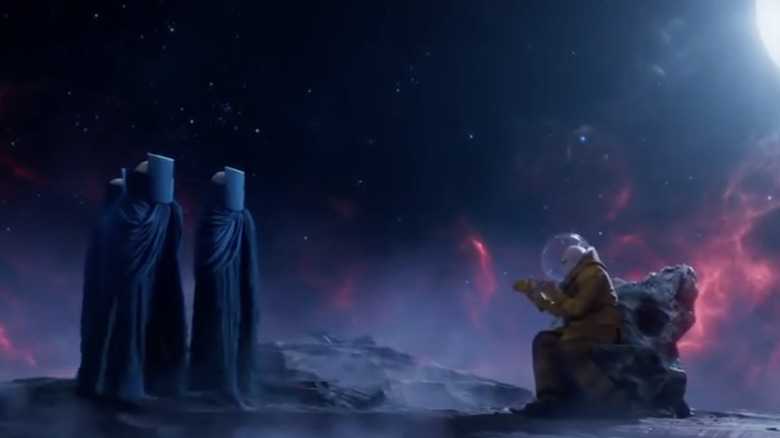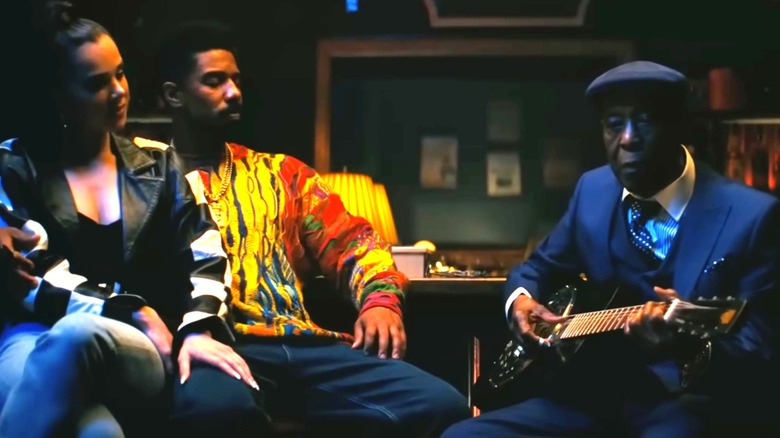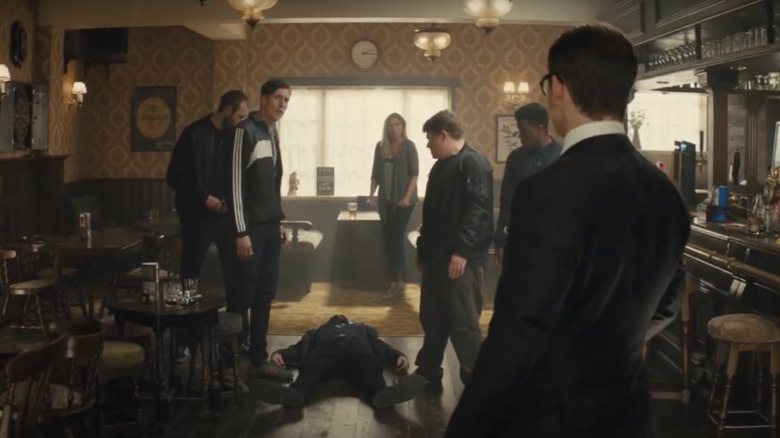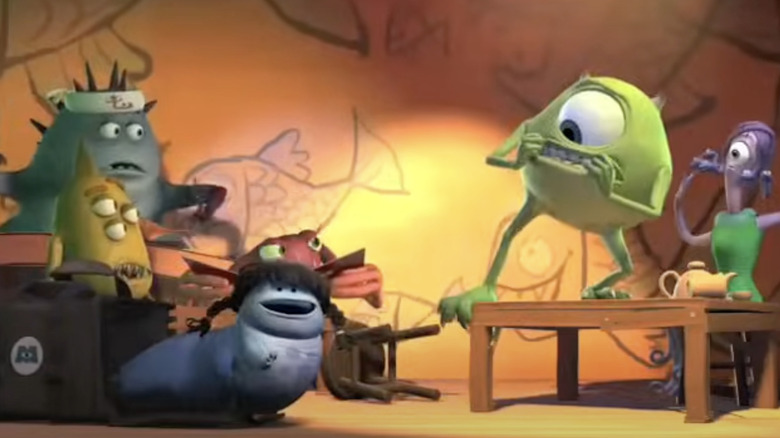The Best End Credits Scenes In Movies Ever
After a really great movie ends and the credits roll, you might be tempted to head out of the theater or stream something else. But it might be a good idea to wait around: Plenty of movies hide a little something extra (or a few extra things) before, during, or after a film's credits, as a little reward for those who stay seated and give each and every person who worked on the film the due they deserve.
The idea of a mid- or post-credits sequence certainly isn't new — some films in the 1960s and '70s notified viewers of upcoming sequels or just let the characters continue the action under the credits themselves — but in recent years, credits scenes have seen a serious boom thanks to superhero films, especially those of the Marvel Cinematic Universe, which use these quick codas to tease upcoming characters, advertise future films, or just add in one last joke.
While they may have perfected the formula, however, Marvel's not alone. From "The Avengers" to "Anchorman," here are some of the best end credits scenes ever.
The Avengers eat shawarma
Marvel has laid claim to a majority of the great post-credit scenes, but perhaps the best one of them, somehow, gives away no new information while satisfying audiences with pure entertainment value alone. The original "The Avengers," written and directed by "Buffy" and "Firefly" creator Joss Whedon, finally brought several heroes of the Marvel Cinematic Universe together to protect Manhattan from Thor's conniving brother Loki and the Chitauri, an alien race trying to overtake Earth.
During the final battle, Tony Stark nearly sacrifices himself but survives, leading to plenty of high-quality banter between him and his colleagues, with Stark suggesting that once the skirmish is over, they grab a bite at a little shawarma place he spotted in midtown Manhattan (he doesn't know what it is, but he wants to try it).
As you might expect, once the credits finish, you're treated to a scene of all of the Avengers silently eating shawarma in a completely wrecked restaurant after the battle. The scene was shot long after the film initially wrapped, thanks to script changes and a brainstorm by Whedon, giving the entire sequence an unexpectedly rich backstory.
Ferris Bueller asks you to leave
John Hughes is responsible for some of the most beloved teen films of all time, including "The Breakfast Club," "Sixteen Candles," and, of course, "Ferris Bueller's Day Off," the definitive "playing hooky" movie, starring a young Matthew Broderick as the titular young troublemaker. Ferris decides to take a day off from school, escape the monotony of the Illinois suburbs, and explore Chicago with his hesitant best friend Cameron (Alan Ruck) and his adventurous girlfriend Sloane (Mia Sara). Thanks to Ferris' ingenuity and several instances of flat-out good luck, the gang gets away with (almost) all of their plans (even though Cameron now has a wrecked car to deal with).
Throughout the film, Ferris repeatedly breaks the fourth wall and speaks directly to the audience, charming then with his musings on his relationship with Sloane or by telling them they should definitely pick up a Ferrari if they can. If audiences wait around until the very end, they're treated to one final fourth wall break: After the credits, Ferris appears in his bathrobe, telling the audience that the movie is over and they should all go home, providing the perfect coda to this quirky film.
Deadpool's Ferris Bueller homage
From the very start of "Deadpool," audiences know they're in for a sarcastic ride, considering that the opening credits themselves omit any real names in favor of jokes like "Starring God's Perfect Idiot" (referring to star Ryan Reynolds) and "Directed by an Overpaid Tool" (referring to director Tim Miller).
A Marvel superhero film about a mercenary turned mutant who undergoes experiments to cure his terminal illness and ends up scarred and mutilated but possessing new powers, "Deadpool" single-handedly revived Reynolds' flagging career and introduced a new generation to the sardonic, red-suited superhero with the driest wit around. Ultimately, this underdog of a movie became the highest-grossing R-rated film of all time (until being edged out by "Deadpool 2," "Oppenheimer," "Joker," and, yes, current crown-holder "Deadpool and Wolverine") and the ninth highest-grossing film of 2016.
One of Deadpool's abilities seems to be awareness that he's in a film, which gives the filmmakers a perfect opportunity to reference another wise-cracking fourth wall breaker. After the credits, Deadpool comes back for one last bit, wearing Ferris Bueller's bathrobe and wandering around an exact replica of the house from "Ferris Bueller's Day Off," mocking the audience for expecting more from a post-credits scene, and eventually admitting that Cable will appear in the next film. Considering the similarities between the two films, there's no better reference, and it's the ideal way to close out a movie as irreverent as "Deadpool."
Napoleon Dynamite's special wedding
An unlikely success, the 2004 comedy "Napoleon Dynamite" certainly didn't seem like a movie that would eventually attract a huge cult following and become a part of the pop culture lexicon. Jon Heder stars as Napoleon himself, a weird, offbeat teenager with a monotone voice and a disgruntled air who gets bullied in school for being unafraid to completely be himself, despite his unpopularity.
He also has to deal with his bizarre brother, Kip (Aaron Ruell), who lives at home with Napoleon and their grandmother (despite being in his early 30s) and spends his time bragging about his internet girlfriend and his cage-fighting skills, though both seem pretty suspect. Kip even embarks on a "get rich quick" scheme with Napoleon to try and go visit his presumably imaginary girlfriend, LaFawnduh (Shondrella Avery). Audiences, along with most of the characters in the film, are shocked when LaFawnduh actually shows up.
If viewers stick around for the entire final credits sequence, they'll even get closure on Kip and LaFawnduh's relationship, with a short scene of their actual wedding. Napoleon gifts them a "wild honeymoon stallion" and Kip sings a song about his love for both LaFawnduh and the technology that brought them together. A perfect continuation of the awkward weirdness that makes up the rest of the film, it's a fun little scene for viewers to discover upon repeat viewings.
One last callback in Airplane!
One of the most influential comedies of all time, "Airplane!" is a pun-filled, slapstick-ridden romp starring Robert Hays and a perfect, fully committed cast. The movie has lived on in infamy since it was released in 1980, and is still considered one of the most beloved films in its genre.
Hays stars as Ted Striker, a war veteran now working as a taxi driver and trying to win back his flight attendant girlfriend Elaine (Julie Hagerty) by boarding one of her flights on a whim. When many passengers and most of the crew end up with food poisoning, Ted, a former fighter pilot, must land the plane. He eventually does so successfully, reuniting with Elaine after a mounting series of absurd, ridiculous mishaps. The film even ends with "Otto," the aircraft's inflatable autopilot, flying off into the sunset with an inflatable female companion.
You might forget, as the film proceeds, that Ted abandoned his taxi and the passenger inside when he spontaneously booked his ticket. Not leaving any stone unturned, the film returns to the passenger just after the credits, with the irate man saying, "Well, I'll give him another 20 minutes, but that's it," making for an absolutely perfect callback to finish the film.
Zombieland's final goodbye
Throughout most of the runtime of the 2009 horror comedy "Zombieland," audiences are pretty sure there are only four people left alive in the zombie-ridden post-apocalyptic world of the film: Columbus (Jesse Eisenberg), a timid, unexpected survivor; Tallahassee (Woody Harrelson), a tough, larger-than-life, bombastic fighter; Wichita (Emma Stone), a protective, tough former con woman; and Little Rock (Abigail Breslin), Wichita's fiery little sister.
At one point, the group stumbles across a Hollywood mansion they think is abandoned, but end up making a startling discovery — Bill Murray (playing himself, obviously) is still alive, and has just been dressing as a zombie to "blend in" so that he can roam freely throughout Los Angeles without getting attacked. Unfortunately, Columbus isn't around for this reveal and accidentally shoots Murray in the chest in his own private movie theater, killing the comedy legend.
The gang leaves Murray behind and moves on, but after the credits, he and Tallahassee share one more semi-tender moment from his death scene. Tallahassee feebly tries to quote Jean-Paul Sartre (in a direct reference to Murray's classic "Caddyshack"), with a seemingly dead Murray eventually chiming in to perform it perfectly, giving this sharp, witty zombie comedy the perfect send-off.
Iron Man kicks off the MCU
Even though the much-maligned 2003 iteration of "Daredevil" had one of the earliest Marvel post-credits scenes, the tradition really began with 2008's "Iron Man," which serves as the first official installment of the Marvel Cinematic Universe. Between Robert Downey Jr.'s outstanding career comeback performance and pitch-perfect direction from Jon Favreau, the film was a smash hit, attracting rave reviews and an outstanding take at the box office.
As the launchpad for the MCU, "Iron Man" had a lot to set up, and it accomplished it in part with one of the most important post-credits sequences of all. After the credits roll, Nick Fury (a surprise cameo from Samuel L. Jackson) appears to tell Tony Stark he isn't the "only superhero" and that he has come to discuss the "Avenger Initiative," even telling Tony that he's become part of a "bigger universe" — quite the understatement considering what the MCU has become in the years since.
Pirates of the Caribbean: At World's End's reunion
The "Pirates of the Caribbean" franchise debuted with "The Curse of the Black Pearl" in 2003 and became one of the biggest film franchises of all time, spanning five films that have earned billions of dollars at the box office both domestically and abroad, as well as providing star turns for big names like Johnny Depp, Orlando Bloom, Keira Knightley, Penelope Cruz, Geoffrey Rush, Ian McShane, and more.
Though the films have faltered critically with each installment, "The Curse of the Black Pearl" remains beloved by critics and fans alike, having introduced audiences not just to Depp's infamous Captain Jack Sparrow, but to Bloom's Will Turner and Knightley's Elizabeth Swann, who ended the first film as a romantic couple.
However, by the end of the third film in the series, "At World's End," the couple has been separated, with Will sailing off on the Dutchman, cursed to remain at sea for a decade and leaving a pregnant Elizabeth behind with only a box containing his heart. A bittersweet conclusion, yes, but if fans of these two wait until the credits are over, they'll be treated to a scene in which Elizabeth and her son, Henry, welcome Will home 10 years later, finally giving the family their happy ending.
Fast Five's big reveal
The "Fast and the Furious" movies make up one of the biggest franchises of all time and the biggest earner for Universal Studios, giving audiences a healthy dose of pure escapism when the real world just gets to be too much. Ever since the first film premiered in 2001, the subsequent nine installments have provided audiences with plenty of car chases, heart-stopping action, and heists galore, relying on a core cast that includes Vin Diesel, Michelle Rodriguez, Dwayne "The Rock" Johnson, Jordana Brewster, the late Paul Walker, and plenty of others.
Viewers came to love Michelle Rodriguez's Letty Ortiz, Dom's (Vin Diesel) wife and an equally skilled mechanic and racer, over the course of the series. During the events of the fourth film, "Fast and Furious," she goes missing while separated from the rest of the crew and is reported dead. However, just as the credits end on "Fast Five," it is revealed that Letty is actually still alive, spotted during a recent robbery of a German military convoy.
Not only did this scene give fans their beloved character back and get them excited for the next film in the series, it raised some intriguing questions about what Letty had been up to since her alleged death.
22 Jump Street's endless sequels
Audiences and critics alike probably groaned when they heard that Channing Tatum and Jonah Hill would be starring in a reboot of the '80s teen cop show "21 Jump Street." This 2012 movie cast the pair as two cops forced to go undercover in high school to infiltrate a drug ring peddling synthetic drugs to teenagers. However, thanks to its tongue-in-cheek attitude, clever script, and winning performances, the film turned out to be a huge success both critically and commercially.
It eventually spawned a sequel, "22 Jump Street." In between gags making fun of its own existence, the follow-up put Tatum and Hill in college to investigate yet another drug ring, and fared equally well with critics and ticket buyers. If you loved the first two films in the series and wanted as many sequels as you could handle, according to the credits of "22 Jump Street," you were in luck.
As the credits roll, the film cycles through an absurd number of sequels, including "25 Jump Street: A Semester at Sea" and "38 Jump Street: Dance Academy." The sequence even features cameos from actors like Bill Hader, Anna Faris, and Seth Rogen (who briefly replaces Jonah Hill for a few of the "films"). So far, sadly, none of these fake credits have come true.
Thanos' promise in Avengers: Age of Ultron
As the Marvel Cinematic Universe chugged along post-"Avengers" and more superheroes popped up in their friends' films, it was clear that everyone would eventually get back together for another installment. In 2015, "Avengers: Age of Ultron" hit theaters, re-assembling the crew with a few additions (including Aaron Taylor-Johnson's Quicksilver, Elizabeth Olsen's Scarlet Witch, and Paul Bettany's Vision). Eventually, after Scarlet Witch stops fighting the Avengers and officially joins the team, they form an entirely new base together, marking a new era for the MCU.
Audiences had met Thanos in a post-credits scene after the first "Avengers" film (in which he was played by actor Damion Poitier). The Mad Titan next appeared briefly in "Guardians of the Galaxy," marking Josh Brolin's debut in the role. But it wasn't until the post-credits scene in "Age of Ultron" that the movies truly set Thanos on a collision course with Earth's Mightiest Heroes. He may do nothing more than pick up a gauntlet and announce, "I'll do it myself," but as audiences now know, this has staggering implications that finally become clear in "Avengers: Infinity War."
Anchorman's news crew just hangs out
One of the most beloved comedies of the 2000s, Adam McKay's "Anchorman: The Legend of Ron Burgundy" has given audiences catchphrases galore and stands the test of time, remaining one of the funniest and most quotable movies in recent history.
Starring Will Ferrell as Ron Burgundy, the titular anchorman, alongside a news team made up of Paul Rudd, David Koechner, Steve Carell, and Christina Applegate, this perfectly absurd film produced so much leftover footage of improv and cut jokes that an entirely new movie could have been made. In fact, it was, in the form of a DVD extra titled "Wake Up, Ron Burgundy: The Lost Movie," which predates "Anchorman 2" and centers on the news team's efforts to expose a bank robbery plot.
With this much leftover footage, it's no surprise that the credits are chock-full of bloopers, cut scenes (including a fan favorite about Brick Tamland's golf tournament), and even bloopers from other movies. You might not think there would be anything left for a post-credits sequence, but wait around and you'll see Burgundy and his news team having a laugh and talking about how much they're laughing and how much they like each other. It's perfectly dumb, perfectly performed, and a perfect final note for this truly weird film.
This Is Spinal Tap's last interview
"This Is Spinal Tap," one of the defining mockumentaries and comedies of all time, focuses on a fictitious band called Spinal Tap (even their name, which refers to an incredibly painful medical procedure, is patently absurd). The movie, released in 1984, was the directorial debut of veteran Hollywood staple Rob Reiner (who also co-wrote), later known for other classics like "The Princess Bride," "Misery," and "When Harry Met Sally," among others.
Cult comedy favorites Michael McKean, Christopher Guest, and Harry Shearer star as the band, with Reiner appearing as the documentarian following them on tour. From incorrectly sized Stonehenges to exploding drummers to the band literally getting lost on their way to the stage, the film is packed full of classic moments beloved by fans, and is still ranked as one of the best satires of all time.
For a movie so full of great jokes already, it seems like an amazing gift to provide fans with even more footage, but Reiner and his crew do, with yet another interview rolling under the credits. Here, the band imagines what their epitaphs might be — for example, David St. Hubbins (McKean) says his would be "Here lies David St. Hubbins, and why not?" Is there a better way to end such an absurd comedy than with a discussion of tombstones?
The Hangover's whole night
The premise of "The Hangover" — a raucous, raunchy comedy starring Bradley Cooper, Ed Helms, and Zach Galifianakis — is exactly what it sounds like. Three men desperately try to connect the dots after a long night of drinking in Las Vegas in hopes of finding their missing friend Doug (Justin Bartha), who is supposed to get married in California the very next day.
As the trio search through the city for clues about where the groom might be, they run into everyone from policemen to doctors to strippers to Mike Tyson, each of whom provides a small piece of the puzzle. Still, the entire evening never really comes together; though they eventually find Doug badly sunburned on the hotel's roof, they go home thinking they'll never really find out what happened on that fateful night.
However, as the wedding takes place and the end credits roll, the three finally find a digital camera containing evidence of everything they did that night, which they agree to delete so nobody can ever see it again. Luckily for audiences, the photos appear during the final credits, and each character (except for Galifianakis' shameless Alan) is horrified by what they see. For the audience, piecing the night together along with the characters themselves makes for a satisfying curtain call.
Guardians of the Galaxy's double surprise
Audiences who loved "Guardians of the Galaxy" were likely extra pleased during the final credits of the first film, which feature two brief sequences chock full of more jokes. An irreverent and wholly quirky superhero adventure, "Guardians" leaned into its offbeat sense of humor, letting characters like Star-Lord (Chris Pratt) and Rocket Raccoon (voiced by Bradley Cooper) riff on each other to a soundtrack of '70s hits by artists like David Bowie and The Jackson 5, all while delighting audiences and critics alike and performing admirably at the box office.
The first end credits sequence features everyone's favorite tree, Groot (voiced by Vin Diesel), reborn as a sapling and dancing along to "I Want You Back" while closely watched by Drax (Dave Bautista). But the film wasn't finished treating its fans. At the very end of the credits, Taneleer "The Collector" Tivan (Benicio del Toro) is seen surveying his damaged showroom, left only with an astronaut dog (a cameo from comic book canine Cosmo) and none other than Howard the Duck, a character with a complicated history who happened to headline the ill-fated first-ever Marvel movie in 1986.
Neither of these moments really advance the plot, but after several super-serious post-credit scenes, they felt like a welcome reprieve.
Iron Man 3's therapy session
A hallmark of the "Iron Man" movies is Tony Stark's biting wit, and with "Iron Man 3" helmed by Shane Black — known for his sharp, witty scripts and direction to match — people could expect plenty of that. In the film, Tony is struggling to deal with the after-effects of "The Avengers." His flashbacks to the traumatic Battle of New York complicate his relationship with Pepper Potts (Gwyneth Paltrow) and make it difficult to face a mysterious terrorist known as the Mandarin (Ben Kingsley).
Though other Avengers are largely excluded from the film (aside from Don Cheadle as Tony's confidant Rhodey, a.k.a. War Machine, a.k.a. Iron Patriot), one other teammate shows up for a humorous post-credits sequence. As the credits end, audiences can hear Tony wrapping up the story in conversation with some sort of therapist, who turns out to be none other than Dr. Bruce Banner (Mark Ruffalo). Banner, who has fallen asleep during Tony's story, protests that he's "not that kind of doctor" and doesn't have the "temperament" to be a therapist. True to form, Stark presses on regardless, continuing to pour his heart out to an unwilling Banner in a perfectly charming and funny final scene.
Captain America preaches patience in Spider-Man: Homecoming
By the time "Spider-Man: Homecoming" hit theaters in 2017, the Marvel Cinematic Universe was rapidly approaching the conclusion of the Infinity Saga. Needless to say, many fans were on the edge of their seats waiting for more details about the next two Avengers movies that would combine all of their favorite MCU characters to make a grand, two-part finale, and assumed there would be an exciting end credits scene after "Spider-Man: Homecoming." Instead, they were greeted by an upright, chipper Captain America (Chris Evans) delivering a public service announcement about the value of patience.
Marvel was including Easter egg-laden end credits scenes at the end of most of their films by 2017, but instead of finishing "Spider-Man: Homecoming" — a really lovely and fun movie about a teenage kid learning how to balance growing up with the responsibility of wielding superhuman abilities — with a serious teaser, the studio decided to be cheeky. There's a classroom scene in "Spider-Man: Homecoming" where a video of Captain America delivering a PSA is briefly shown, so Marvel called back to that moment by having Cap be the one to deliver the bad news: Sometimes, patience doesn't always pay off. This little bit of meta humor is actually one of the best MCU end credits scenes, poking fun at the tradition that Marvel helped to popularize.
Bridesmaids' naughty home movie
"Bridesmaids" was a great showcase for several comedic actors, but perhaps none more-so than Melissa McCarthy. While McCarthy had some name recognition before the Paul Feig-directed comedy dropped in 2011 (she played Lorelai's best friend on "Gilmore Girls" for seven seasons, after all), it wasn't until after the film was released that she became a household name. As Megan, Lillian's (Maya Rudolph) future sister-in-law, McCarthy stole nearly every scene she was in with her frenetic comedy and the sincerity of her performance.
The credits of "Bridesmaids" roll next to extended footage of the cast dancing to Wilson Phillips as they perform "Hold On." Toward the end of the credits, the screen flashes and the audience is suddenly watching a sexy videotape made by Megan and the Air Marshall she propositioned in the film. The Air Marshall is actually played by McCarthy's real-life husband, Ben Falcone, and their sexual dynamic in the end credits scene is a hilarious capper to a great film, even if it's a little hard to watch (it might take away your appetite for giant sub sandwiches).
Jeremy Renner shows off his pipes in Tag
"Tag" follows the antics of five grown men who grew up playing tag together and never stopped. Based on a true story, the movie's friend group has maintained a game of tag with each other for decades, using the game to stay close with each other and continue having childlike fun as adults. Four of the friends, Bob (Jon Hamm), Hoagie (Ed Helms), Chili (Jake Johnson), and Kevin (Hannibal Buress), have been regularly tagging each other the whole time, but their fifth friend, Jerry (Jeremy Renner), has evaded being "it" for as long as they've been playing.
This underrated, raucous, good-hearted comedy flick has a stellar cast and plenty of opportunities for each individual to shine. One of the funniest parts of the movie takes place in tandem with the end-credits. The unmistakable opening notes of "Mmm Mmm Mmm Mmm" by the Crash Test Dummies begin to play before Jeremy Renner's floating face appears in black and white. Renner then belts out the song, stone-faced and with some impressive pipes. The best part, though, has to be when the other four leads take turns joining him, singing along with "mmm mmm mmm mmm" and other backup parts.
Scott gets left in the Quantum Realm in Ant-Man and the Wasp
"Ant-Man and the Wasp" was one of only two Marvel Cinematic Universe films that came out between "Avengers: Infinity War" and "Avengers: Endgame." At the end of "Avengers: Infinity War," half of the universe's living population is turned to dust by Thanos. Unfortunately for Scott Lang, aka Ant-Man, this means that his girlfriend Hope Van Dyne, aka The Wasp, as well as her mother and father, Janet Van Dyne and Hank Pym (the first Wasp and Ant-Man, respectively), are all evaporated into dust while he is traversing the Quantum Realm under their supervision.
This is a great end credits scene because it reminds viewers of the stakes of "Avengers: Infinity War" without taking away from the lighthearted tone of the actual film it followed. It also means that Scott is in a seemingly hopeless situation going into the five-year gap between "Avengers: Infinity War" and "Avengers: Endgame." Without the help of Hope and her parents, Scott has no one to pull him out of the Quantum Realm. It's a delicious teaser and no doubt increased a lot of anxiety over the state of the MCU at the start of "Avengers: Endgame."
Roy finds out that Nyles escaped the time loop in Palm Springs
There are several great movies that had the misfortune of being released during the COVID-19 pandemic and therefore flew under the radar. One such film is "Palm Springs," a beautiful, unassuming little rom-com that came out on streaming in July 2020. The film follows Nyles (Andy Samberg) and Sarah (Cristin Milioti), both attendees of the same wedding. They don't really meet, however, until Sarah is inadvertently pulled into the endless 24-hour time loop that Nyles has been stuck in for countless days. Only one other person, Roy (J.K. Simmons) — also an attendee of the wedding — is stuck in the loop as well.
J.K. Simmons is always a joy to watch even when he's in a supporting role, and while his purpose in "Palm Springs" is limited, he uses his screen time to perfection. Nyles and Sarah manage to escape the loop by detonating a bomb at the exact moment it was due to start over, but by the end of the film, Roy is still looping. In the end credits scene, Roy approaches Nyles and tells him that he got Sarah's message about how to escape. Of course, this version of Nyles has no idea what he's talking about, because every loop creates a new timeline. This post credits scene is great because it not only tells us that Nyles and Sarah escaped the loop, but that they also gave Roy the info he needs to escape, too, making it a happy ending all around.
Pacific Rim's surprise survival
We tend to prefer when Ron Perlman characters stick around (he is a fantastic addition to any story), but in "Pacific Rim," his character, Hannibal Chau, definitely has it coming when a baby Kaiju swallows him up in one bite. Director Guillermo del Toro (who also directed Perlman as the titular character in his "Hellboy" movies,) apparently feels the same way, as Perlman's Chau makes a surprise comeback in the end credits scene of his 2013 monster movie.
In the scene, the camera zooms in on the aftermath of the Kaiju attack in Tokyo. A group of people are collecting monster parts from the street, and the camera stops on a big, indigo mass of slippery flesh. Viewers then get the pleasure of watching Ron Perlman cut himself out of the stomach of the Kaiju that ate him earlier in the film. Chau looks inconvenienced, more than anything else, and shouts out, "Where is my goddamn shoe?"
Peter Parker's identity is revealed in Spider-Man: Far From Home
Ever since Marvel Studios took stewardship of Spider-Man from Sony, the franchise has been firing on all cylinders. All the movies starring Tom Holland as the titular web-slinger have received acclaim and been financially successful. In the second film, "Spider-Man: Far From Home," Peter Parker goes on a trip to Europe organized by his high school over the summer. There, he must not only contend with his growing feelings for classmate MJ (Zendaya) but also with a rash of extreme elemental attacks secretly being carried out by a villain named Mysterio (Jake Gyllenhaal).
Peter is able to stop Mysterio, but not before the villain alters footage of their encounter to make Spider-Man look like the person behind the drone attack on London and reveals Peter's identity to the world. This big moment comes in the film's end credits scene. Peter has just finished taking MJ on a ride through New York City via his webs when a news alert broadcasts across Time Square. Mysterio's doctored footage is shown, sending Peter into shock and horror and setting up excellent stakes for the next Spider-Man film. The best part of the scene, though, is the reappearance of J.K. Simmons' character J. Jonah Jameson from the Tobey Maguire Spider-Man movies.
Akira comes for Caine in John Wick 4
In the box office hit "John Wick 4," audiences are introduced to a blind assassin named Caine (Donnie Yen) who has made a deal with the High Table: As long as they do not harm or kill his daughter, he will take out anyone they desire. When they name Caine's old friend John Wick (Keanu Reeves), he hunts him around the world. After an extended fight in the Osaka Continental, it's clear that he's nearly as deadly as John, despite his lack of vision. Caine is forced to kill the manager of the Osaka Continental, Koji (Hiroyuki Sanada), and this leaves Koji's daughter, Akira (Rina Sawayama), devastated and desperate for revenge. Akira is too wounded to follow Caine out of the Continental, but Caine looks over his shoulder and says, "I'll be waiting for you," before walking away.
By the time the end credits are rolling on "John Wick 4," audience members have likely stopped wondering about Akira, distracted with the film's awesome ending. Suddenly a scene of Caine walking in a crowded area in Paris starts playing. Caine is holding a bouquet of flowers, approaching a young, female violinist — his daughter. Right before he gets there, Akira, hooded and wearing all black, approaches him. Akira readies her switch blade, and the screen goes black. It's a fantastic teaser for the upcoming "John Wick" spin-off movie centered around Caine.
A Knight's Tale closes on a farting contest
"A Knight's Tale" is one of the most undervalued movies of the 2000s. While set in medieval times, the movie is boldly committed to the inclusion of stylistic anachronisms, including costume accessories that are just a little bit too modern and a killer soundtrack that seeps into the cracks of the film (for example, one scene shows a crowd stomping along to the beat of "We Will Rock You" by Queen). As well as that, it presents two interesting, complex female characters in Kate (Laura Fraser) and Jocelyn (Shannyn Sossamon) — setting it apart from many action films — and embraces a clever, satisfying sort of humor.
That humor runs the gamut. It can be as nimble as the part of the movie where, after William (Heath Ledger) vows that he will win every bout of his upcoming tournament in her name, Jocelyn instead bids that he lose them. Instead of letting him fulfill his own desire to win, she dares him to set that desire aside and experience humiliation and physical pain by purposely losing every round of a tournament. It resolves beautifully and finds a way to subvert chivalrous stereotypes. On the simpler side of humor, we have the film's end credit scene. No less entertaining, viewers can find footage of side characters Roland (Mark Addy), Wat (Alan Tudyk), Geoffrey Chaucer (Paul Bettany), and Kate sitting in a tavern attic, having a farting contest.
Guardians of the Galaxy Vol. 2 has the best Stan Lee cameo
"Guardians of the Galaxy Vol. 2" came out near the start of the Marvel Cinematic Universe's third phase, back when the franchise was an all-consuming force in Hollywood and moviegoers were desperate for hints about what could be in store for the MCU's many heroes. As such, "Guardians of the Galaxy Vol. 2" had a lot to live up to in terms of end credits scenes. When you count mid-credits scenes and post-credits scenes, there are actually five in total here, and they're all good.
The first scene shows Kraglin (Sean Gunn), new member of the Guardians, attempting to direct Yondu's (Michael Rooker) sonic arrow with his whistles. While he has some success, he accidentally shoots the slim, zipping arrow into Drax (Dave Bautista), who roars out. The second scene shows a sect of ravagers led by Stakar Ogord, aka Starhawk (Sylvester Stallone). Starhawk's whole crew is there, including Michelle Yeoh's Aleta Ogord and the diamond-headed Martinex T'Naga (Michael Rosenbaum). The third scene shows Ayesha (Elizabeth Debicki), high priestess of the Sovereign people, looking a wreck and staring at the pod that will birth Adam Warlock. The fourth scene depicts Peter Quill (Chris Pratt) and Groot mirroring an exchange between a fed up parent and an angsty teen over a messy room.
The last end credits scene — and the best of the bunch, in our opinion — shows Stan Lee, creator of so many of Marvel's most famous heroes, reporting everything he has seen to the Watchers. This is a reference to the many MCU cameos that Stan Lee filmed before his death in 2018. It's a lovely way to tie a bow around his presence in the pre-2018 MCU films and one of the best end credits scenes of all time.
Old friends reunite in Sinners
Ryan Coogler has directed only five feature films — "Fruitvale Station," "Creed," "Black Panther," "Black Panther: Wakanda Forever," and "Sinners" — and each one has been received well by critics. His most recent film, "Sinners," takes place in 1932 and follows identical twin brothers Smoke and Stack (both portrayed by Michael B. Jordan), who manage to embezzle some money from the Chicago mob and use it to purchase a sawmill back home in Mississippi. They turn it into a juke joint with the help of many community members, including a young guitarist named Sammie (Miles Caton) with a prodigious talent. He wants to be a blues musician, despite his father warning him that the music is supernatural.
Long story short, everyone but Sammie ends the movie either dead or turned into an immortal, bloodsucking vampire. Sammie is the sole human survivor thanks to Smoke, who knows that Sammie is special and deserves a good life. In an end credits scene, the camera finds an elderly Sammie in a Chicago bar in 1992. He's been a touring blues musician his whole life, but he immediately recognizes Stack and his Stack's paramour, Mary (Hailee Steinfeld), when they walk through the door, despite their spiffy, '90s duds. The scene hits several tender points, the most poignant of which being Stack and Sammie's commiseration over their shared love of Smoke, now long-dead, and the one night of freedom they enjoyed before the vampires came.
Eggsy teaches his stepdad a lesson in Kingsman: The Secret Service
Part of what's so fun about "Kingsman: The Secret Service" is the style — the clothes, Harry Hart's (Colin Firth) immaculate flat, the Kingsman uniforms and tools — but protagonist Eggsy (Taron Egerton) also has to take a lot of the credit. Despite his upbringing in a rough part of London, Eggsy has the confidence of a born-and-raised prince. That said, all the bravado in the world can't help him beat up his mom's (Samantha Womack) abusive husband, Dean (Geoff Bell). Thankfully, director Matthew Vaughn didn't want to leave any loose ends, so he included an end credits scene wherein Eggsy goes to the pub where his stepfather often drags his mother to hang out with his crew.
Eggsy is now a Kingsman, and as such is dressed in the finest Savile Row suit. He enters the pub and confidently challenges Dean and his entourage. Dean is initially unbothered, but his friends become concerned when they notice Eggsy locking the pub door, a callback to when Harry did the same thing earlier in the film before giving Dean's henchmen a thorough beatdown. Eggsy says the same thing Harry did ("Manners maketh man") before using his umbrella to launch a pint glass at his abusive stepdad in one swift movement, knocking him out cold to the sheer astonishment of his goons. The end credits scene cuts out before the full fight, but, thanks to the earlier scene with Harry, we know exactly what's about to happen.
Mike puts on his musical in Monsters, Inc.
The team at Pixar is not only committed to making its films fun and playful, but also rich in references and Easter eggs. 2001's "Monsters, Inc." is about a monster world that connects to the real world through closet doors in the bedrooms of children around the globe. The monsters are working stiffs, just like people, but they come out of said closets to scare kids so they can collect screams (which they use as energy). When monsters Sully (John Goodman) and Mike Wazowski (Billy Crystal) discover that they've accidentally let a child into their world through a closet door, they scramble to hide her, telling many lies to their co-workers — they've been led to believe that children are highly dangerous.
A comedy of errors occurs as they attempt to locate the child and return her to the human world. When Mike is overheard telling Sully to "Put that thing back where it came from or so help me," they play it off by pretending that they're rehearsing a scene from an upcoming company musical. Mike even makes up a song on the spot to sell the lie. It seems like a simple, one-scene joke, and in many movies it would have been, but Pixar went the extra mile, including an end credits scene wherein Mike and Sully actually do put on this musical — starring, written, directed, and produced by Mike — for their fellow monsters. It's a long post credits scene, with many clips of monsters musically reenacting scenes from the movie, and every second is a delight.
